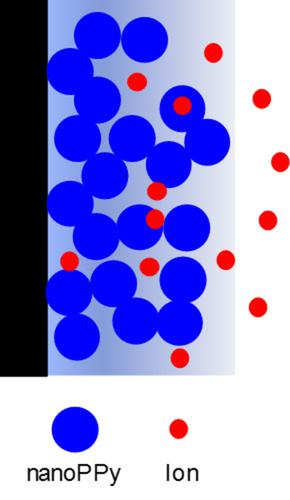当前位置:
X-MOL 学术
›
Electroanalysis
›
论文详情
Our official English website, www.x-mol.net, welcomes your feedback! (Note: you will need to create a separate account there.)
Electrochemical Properties of Polypyrrole Nanoparticles – The Role of Doping Ions and Synthesis Medium
Electroanalysis ( IF 3 ) Pub Date : 2017-12-29 , DOI: 10.1002/elan.201700685 Ewa Jaworska 1 , Anna Kisiel 1 , Agata Michalska 1 , Krzysztof Maksymiuk 1
Electroanalysis ( IF 3 ) Pub Date : 2017-12-29 , DOI: 10.1002/elan.201700685 Ewa Jaworska 1 , Anna Kisiel 1 , Agata Michalska 1 , Krzysztof Maksymiuk 1
Affiliation

|
Electrochemical properties of polypyrrole nanoparticles coated on glassy carbon electrodes were studied. The nanoparticles were obtained in a chemical polymerization step using a novel templateless procedure – oxidation of pyrrole released either from poly (n‐butyl acrylate) microspheres or from micelles of crosslinked alternating polymer (poly (maleic anhydride‐alt‐1‐octadecene)). Voltammetric measurements confirmed high ion transport rate inside the polymer and minor influence of the kind of doping ion and electrolyte ions present in the solution. However, electrochemical impedance spectroscopy measurements revealed a significant difference in the properties of polypyrrole nanoparticles, depending on the synthesis conditions. In case of polypyrrole synthesized in the presence of poly (n‐butyl acrylate) microspheres EIS spectra were almost independent of kind of electrolyte ions and doping anion, pointing to exposed bulk capacitive properties. On the other hand, polypyrrole nanoparticles obtained in the presence of alternating polymer micelles represent a typical constant phase element behavior with impedance significantly dependent on the kind of oxidizing (doping) anion. Due to their capacitive properties polypyrrole nanoparticles obtained in the presence of poly (n‐butyl acrylate) microspheres were applied as solid contacts in ion‐selective electrodes.
中文翻译:

聚吡咯纳米粒子的电化学性质-掺杂离子和合成介质的作用
研究了涂覆在玻璃碳电极上的聚吡咯纳米粒子的电化学性能。纳米粒子是通过化学聚合步骤使用新颖的无模板程序获得的-从聚丙烯酸正丁酯微球或交联交替聚合物胶束(聚(马来酸酐-alt-1-十八碳烯))释放的吡咯氧化。伏安法测量证实了聚合物内部较高的离子传输速率以及溶液中存在的掺杂离子和电解质离子的种类的较小影响。然而,电化学阻抗谱测量显示,取决于合成条件,聚吡咯纳米颗粒的性质存在显着差异。对于在聚丙烯酸正丁酯存在下合成的聚吡咯微球,EIS光谱几乎与电解质离子和掺杂阴离子的种类无关,这表明裸露的电容性质。另一方面,在交替的聚合物胶束存在下获得的聚吡咯纳米颗粒表现出典型的恒定相元素行为,其阻抗显着取决于氧化(掺杂)阴离子的种类。由于其电容性,在聚丙烯酸正丁酯微球存在下获得的聚吡咯纳米颗粒被用作离子选择电极中的固体触点。在交替的聚合物胶束存在下获得的聚吡咯纳米粒子表现出典型的恒定相元素行为,其阻抗显着取决于氧化(掺杂)阴离子的种类。由于其电容性,在聚丙烯酸正丁酯微球存在下获得的聚吡咯纳米颗粒被用作离子选择电极中的固体触点。在交替的聚合物胶束存在下获得的聚吡咯纳米颗粒表现出典型的恒定相元素行为,其阻抗显着取决于氧化(掺杂)阴离子的种类。由于其电容性,在聚丙烯酸正丁酯微球存在下获得的聚吡咯纳米颗粒被用作离子选择电极中的固体触点。
更新日期:2017-12-29
中文翻译:

聚吡咯纳米粒子的电化学性质-掺杂离子和合成介质的作用
研究了涂覆在玻璃碳电极上的聚吡咯纳米粒子的电化学性能。纳米粒子是通过化学聚合步骤使用新颖的无模板程序获得的-从聚丙烯酸正丁酯微球或交联交替聚合物胶束(聚(马来酸酐-alt-1-十八碳烯))释放的吡咯氧化。伏安法测量证实了聚合物内部较高的离子传输速率以及溶液中存在的掺杂离子和电解质离子的种类的较小影响。然而,电化学阻抗谱测量显示,取决于合成条件,聚吡咯纳米颗粒的性质存在显着差异。对于在聚丙烯酸正丁酯存在下合成的聚吡咯微球,EIS光谱几乎与电解质离子和掺杂阴离子的种类无关,这表明裸露的电容性质。另一方面,在交替的聚合物胶束存在下获得的聚吡咯纳米颗粒表现出典型的恒定相元素行为,其阻抗显着取决于氧化(掺杂)阴离子的种类。由于其电容性,在聚丙烯酸正丁酯微球存在下获得的聚吡咯纳米颗粒被用作离子选择电极中的固体触点。在交替的聚合物胶束存在下获得的聚吡咯纳米粒子表现出典型的恒定相元素行为,其阻抗显着取决于氧化(掺杂)阴离子的种类。由于其电容性,在聚丙烯酸正丁酯微球存在下获得的聚吡咯纳米颗粒被用作离子选择电极中的固体触点。在交替的聚合物胶束存在下获得的聚吡咯纳米颗粒表现出典型的恒定相元素行为,其阻抗显着取决于氧化(掺杂)阴离子的种类。由于其电容性,在聚丙烯酸正丁酯微球存在下获得的聚吡咯纳米颗粒被用作离子选择电极中的固体触点。



























 京公网安备 11010802027423号
京公网安备 11010802027423号